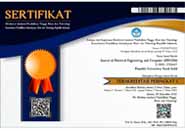Implementation of The Behaviorally Anchored Rating Scale Method for Employee Performance Evaluation of MSMEs in Surabaya City Based on Information Technology
Authors (s)
(1) Darmanto Darmanto (Universitas Widya Kartika Surabaya)
Indonesia
(2) * Erwin - Dhaniswara


 (Universitas Widya Kartika Surabaya)
(Universitas Widya Kartika Surabaya) Indonesia
(3) Yonatan Widianto (Universitas Widya Kartika Surabaya)
Indonesia
(*) Corresponding Author
AbstractMicro, Small, and Medium Enterprises (MSMEs) in Surabaya encounter persistent challenges in conducting objective evaluations of employee performance. To address this issue, the present study introduces the application of the Behaviorally Anchored Rating Scale (BARS), employing both qualitative and quantitative approaches supported by Information Technology (IT). BARS enables performance appraisal based on specific and observable work behaviors, thereby mitigating subjectivity and enhancing the fairness of evaluations. The integration of IT further streamlines data collection processes while reducing administrative complexity. In this study, an open-source web-based application was developed and customized to align with the operational requirements of MSMEs. The primary objective is to design and implement a performance evaluation system grounded in BARS and IT, supporting MSMEs in the formulation of realistic performance benchmarks and more effective human resource management practices. The research methodology adopts the ADDIE Research and Development model, encompassing the phases of analysis, design, development, implementation, and evaluation. System reliability was assessed through black box testing, with results indicating validity and consistency across all scenarios. The findings confirm the successful deployment of a multi-user web application capability in facilitating efficient, accurate, and systematic employee performance evaluations within MSMEs
|
Keywords
Employee performance MSMEs BARS ADDIE
Full Text: PDF
Refbacks
- There are currently no refbacks.
Copyright (c) 2025 Erwin - Dhaniswara

This work is licensed under a Creative Commons Attribution License (CC BY-SA 4.0)
Journal of Electrical Engineering and Computer (JEECOM)
Published by LP3M Nurul Jadid University, Indonesia, Probolinggo, East Java, Indonesia.








